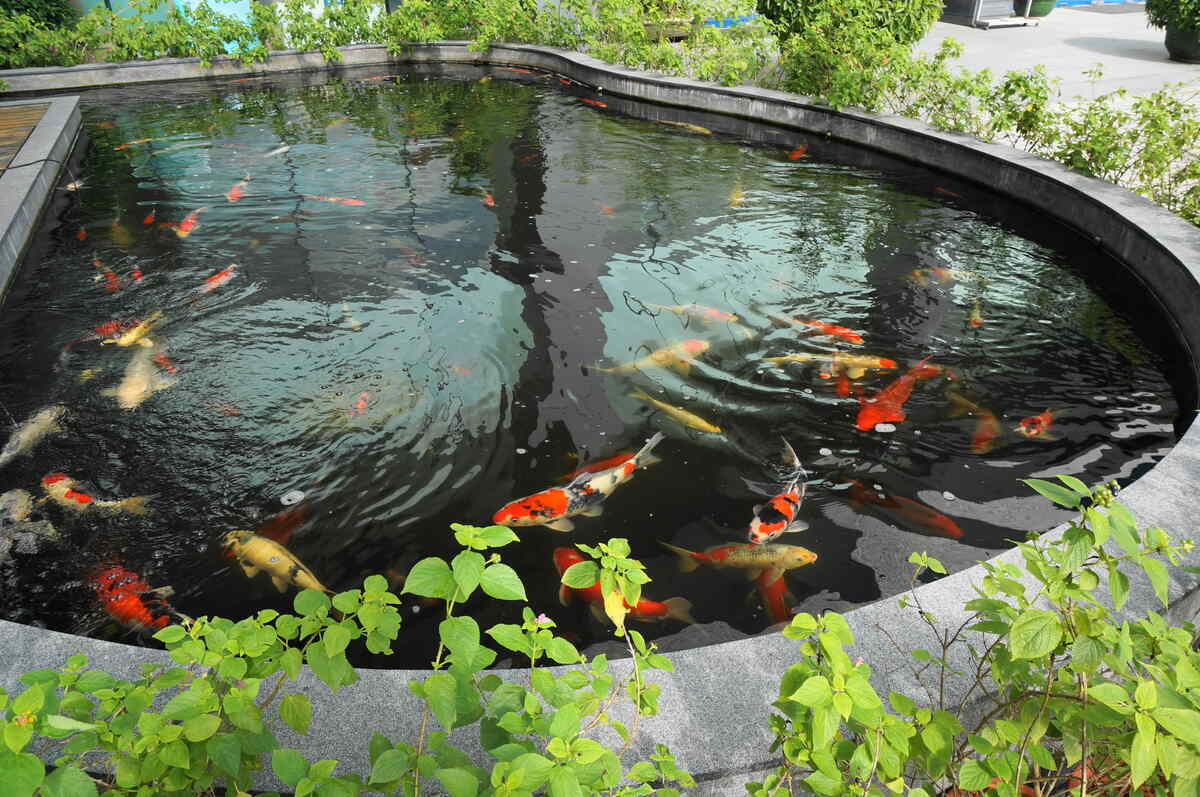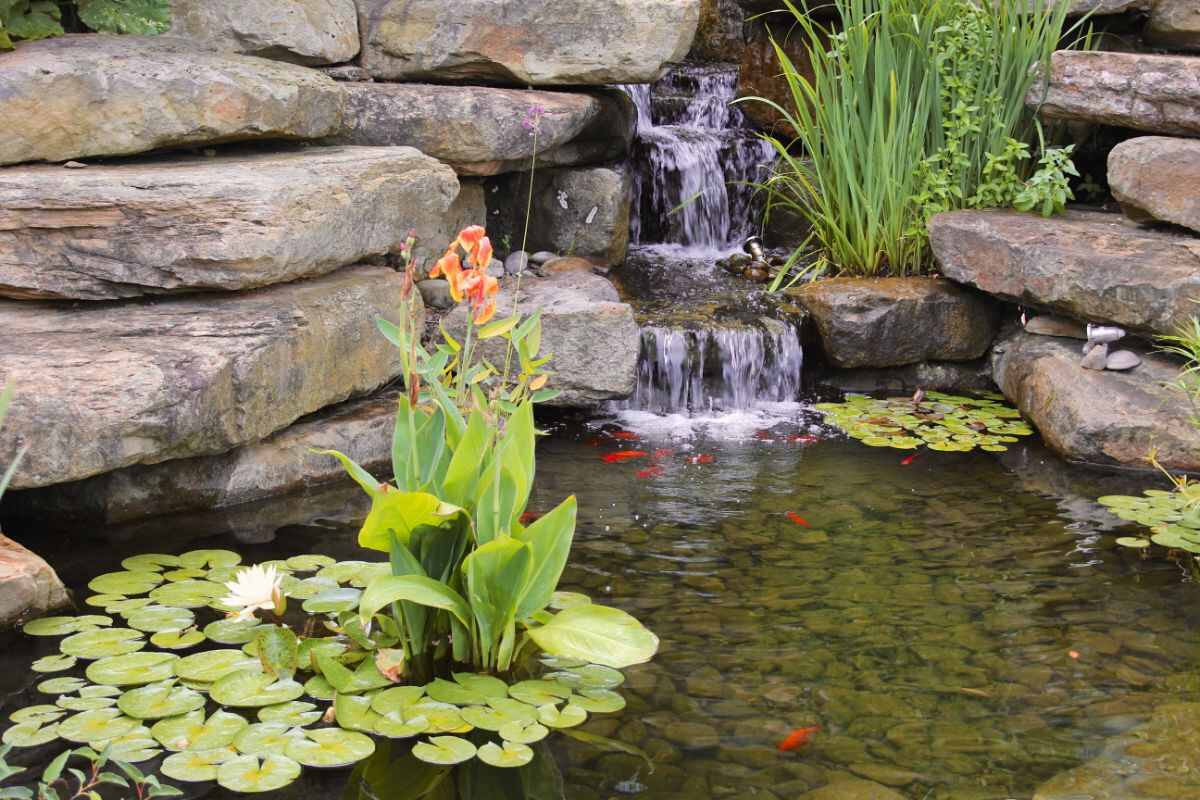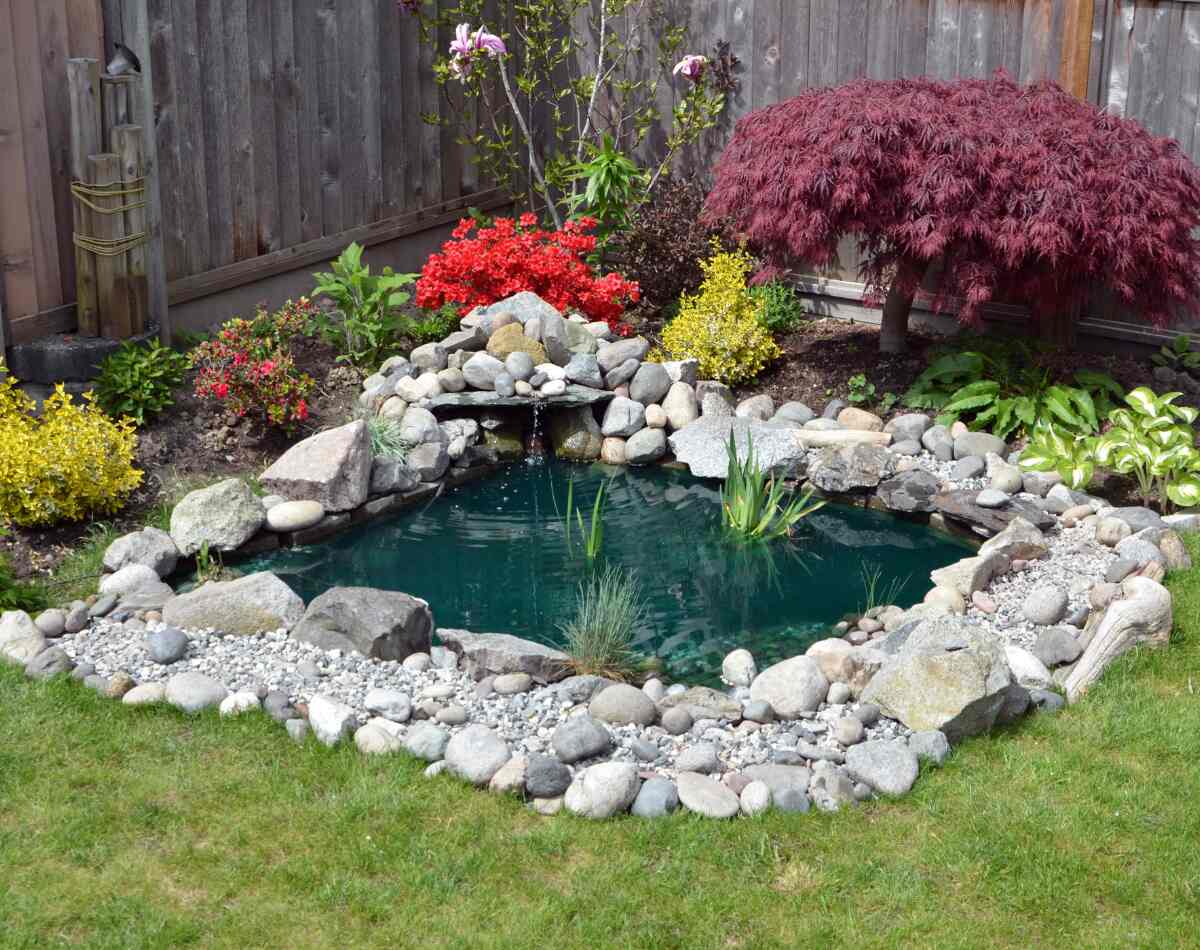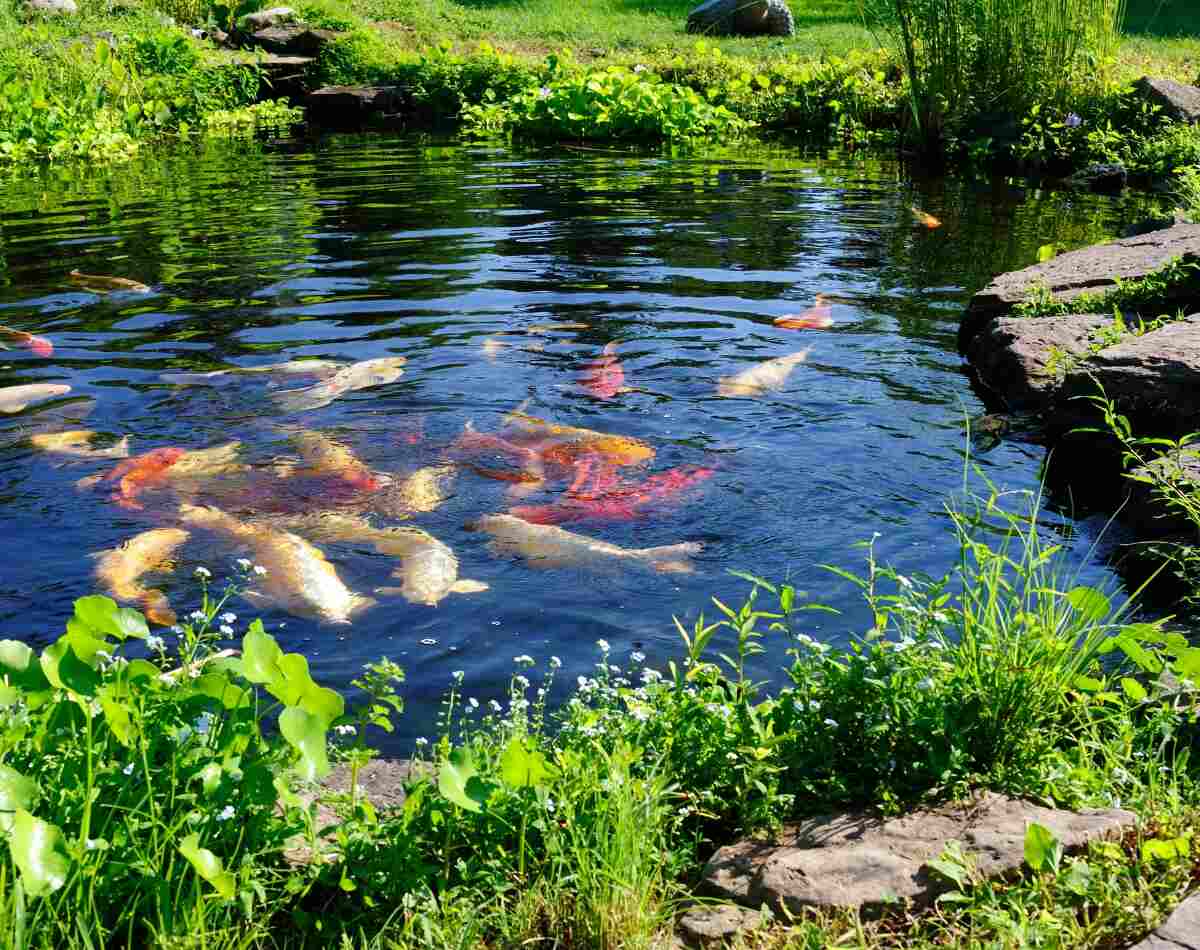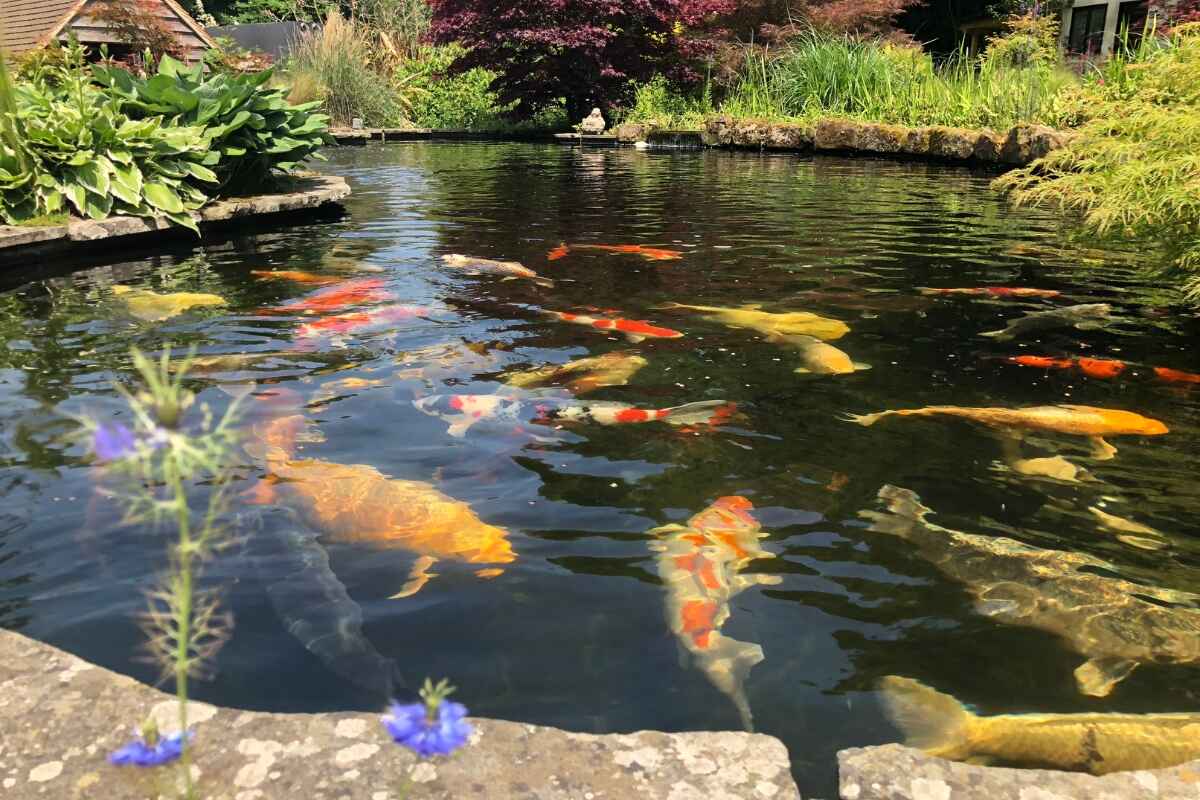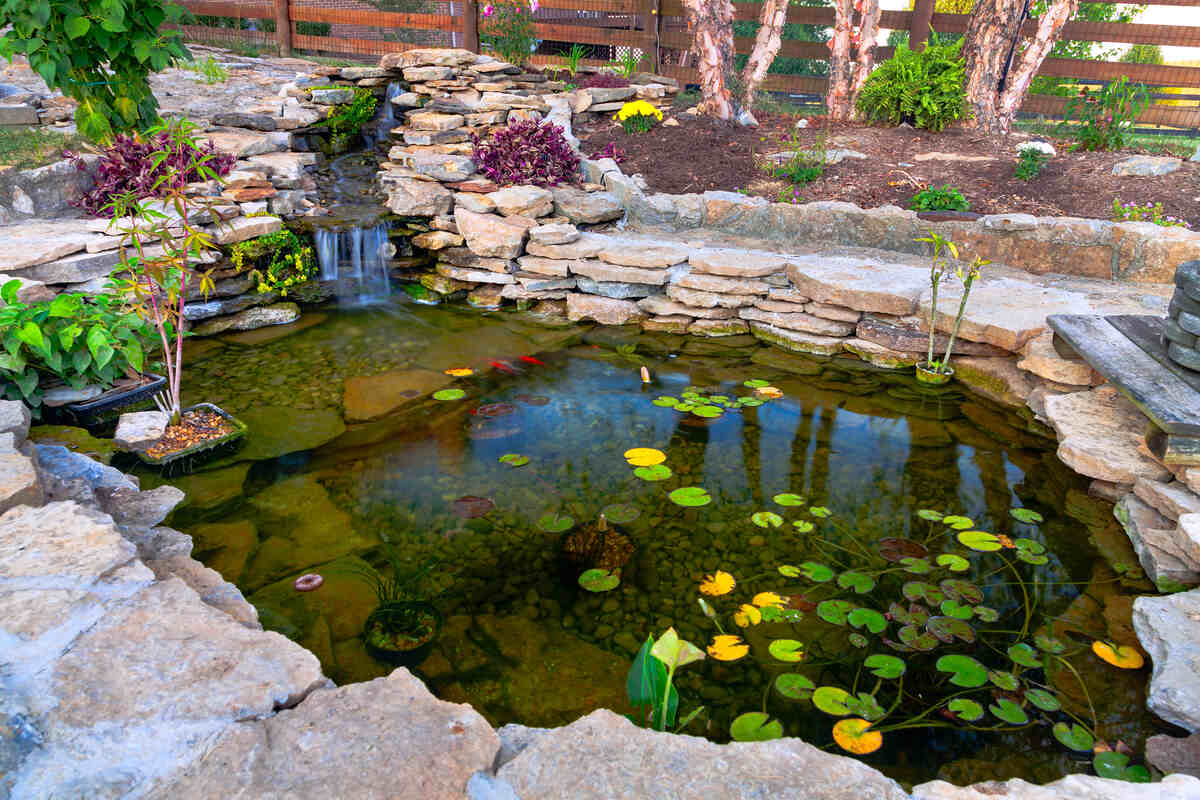
Watching colorful koi fish swimming through your crystal-clear pond is both a joy and an accomplishment. Koi pond maintenance is not difficult, but it requires commitment. So, make sure you’re up for the job before building a koi pond in your backyard. If you already own one, here’s our complete guide to koi pond maintenance to help you keep an easy and satisfying pond maintenance routine.
- Start From Installation
- Avoid Overfeeding the Fish
- Scoop Up Leaves and Debris
- Test the Water
- Keep the Water Fresh
- Add Beneficial Bacteria
- Checking and Cleaning Filters
- Check the Water Pump Regularly
- Keep Pond Plants Under Control
- Don’t Overcrowd Your Koi Pond
- Take Care of Aquascape Design
- Create a Schedule
- Follow Seasonal Changes
- Go for a Professional Pond Cleaning Once a Year
- FAQ
Start From Installation
Plan and build your pond with maintenance in mind, and your koi will love it. Koi ponds are complex ecosystems, and every element matters. Here are some key ideas to consider for a pond that is both beautiful and easy to care for:
- In design, avoid corners where water can stagnate.
- Make sure you have some shadow (it keeps algae under control and the water cool).
- Go for a good liner to avoid water leaks.
- Choose a pump that can circulate 1.5 times your pond volume each hour to aerate properly.
- Add a filter that matches your pond’s capacity to keep the water clear and clean.
- Install a skimmer to collect debris 24/7.
- Hire a pro to install everything the right way.
- Be mindful of the water plants.
- Buy healthy koi from trusted sources.
Do you already have a koi pond? Let’s talk about how to take care of a koi pond so you can keep it clean and healthy with minimal effort.
Avoid Overfeeding the Fish
A key maintenance tip to keep your koi happy is to feed the fish two to four times a day for up to 5 minutes. After 10 minutes, collect the remains to avoid build-up on the bottom of the pond.
Why so much care? Overfeeding leads to excess nutrients in the pond from food remains and fish waste. Algae will bloom in such a rich environment, making the pond water green and limiting oxygen. Bacteria also thrive, converting nutrients into harmful ammonia that can make the fish sick.
Keep in mind that the proper amount of food depends on:
- Size and number of koi – Koi eat more as they grow. Observe their behavior and end the feeding session when they become less interested in the food.
- Koi plants – You can feed koi less often with enjoyable snacks such as sweet flag, water lettuce, hyacinth, or lilies in the pond.
- Water temperature – Koi metabolism varies with pond water temperature. They eat less when winter comes and get hungrier in the summer.
Here are some basic rules to help you adjust feeding according to water temperature.
| Water Temperature | How Often to Feed |
| Under 48°F | Stop feeding. The koi are hibernating and not eating until spring. |
| 48°F to 64°F | Feed once a day. It’s essential to keep the water clean and oxygenated. |
| 65°F to 87°F | Feed two to four times a day. |
| Over 88°F | Feed once a day. |
Pro tip: Use an auto-feeder when you’re away or if work keeps you too busy. But still check the fish daily for a few minutes to relax your mind and see how they’re doing.
Scoop Up Leaves and Debris
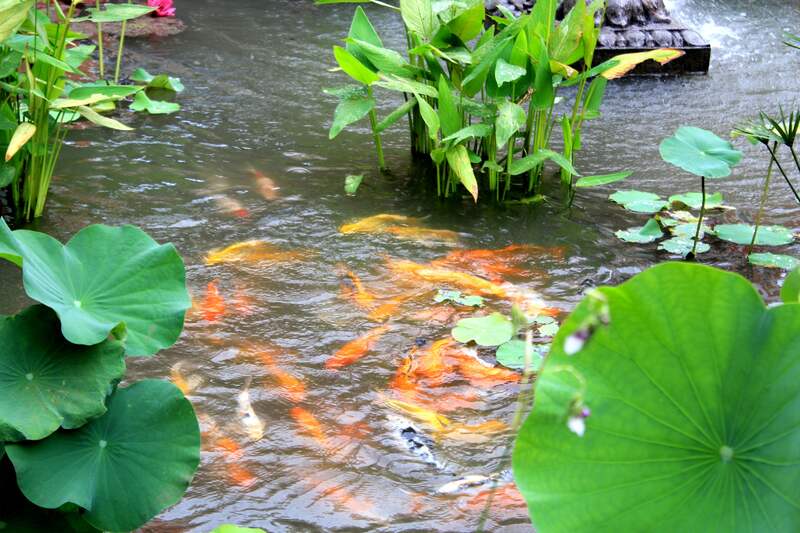
The best way to keep your koi ecosystem clean and balanced is to scoop up floating leaves and debris periodically. Invest a few minutes daily or a few times a week and use a hand net to collect:
- Fallen leaves, twigs, and sticks from trees and shrubs around the pond.
- Vegetable residue from your aquatic plants.
- Plastic and any other debris you see floating around.
This little gesture will make the whole maintenance process a lot easier.
Test the Water
Test the pond water once a week and after heavy storms or adding fresh water to your pond. Check the following:
- Water pH, levels of ammonia, nitrates, and phosphate (with a strip test or liquid test kit).
- Water temperature (with a pond thermometer).
- Oxygen levels (digital DO meter).
Here are the average recommended values you should try to maintain:
| What to Check | Recommended Values for Koi |
| pH levels | 6.5 to 8.5 |
| Ammonia | 0 (as low as possible) |
| Nitrites | 0 (as low as possible) |
| Nitrates | A value of up to 20 ppm is acceptable since plants can deal with it. |
| Phosphate | Under 0.05 ppm |
| Dissolved Oxygen Level | 6 ppm to 8 ppm (measure with a digital DO meter) |
| Water Temperature | 65° to 87°F |
Pro tip: Signs of oxygen depletion to keep an eye on:
- Fish coming up often and gasping for air
- Algae bloom
- High levels of ammonia and nitrates
- Water surface covered in plant residue
Keep the Water Fresh
Replace 10% to 15% of the water once a week or at the very least once a month. You can go up to 25% during summer to keep the pond cool and prevent a high ammonia level. But 10% will be enough during winter.
- Use a de-chlorinator for the chlorine or chloramine in tap water before adding it to your pond.
- Replace the water slowly to avoid stressing the fish by changing the temperature too fast.
Pro tip: Watch the water level regularly. If it drops faster than evaporation can explain, consider checking for leaks in the pond liner or filtration system.
Add Beneficial Bacteria
Colonies of good bacteria keep the water clean and the koi fish healthy by:
- Turning harmful ammonia into less dangerous nitrates.
- Preventing algae blooms.
- Consuming fish waste and organic debris.
They also make the pond easier to maintain. You can find beneficial bacteria for your pond online and at brick & mortar stores. Make sure to follow the instructions on the package. Some koi pond cleaners also contain beneficial bacteria, which help to get rid of excess waste and muck.
Checking and Cleaning Filters
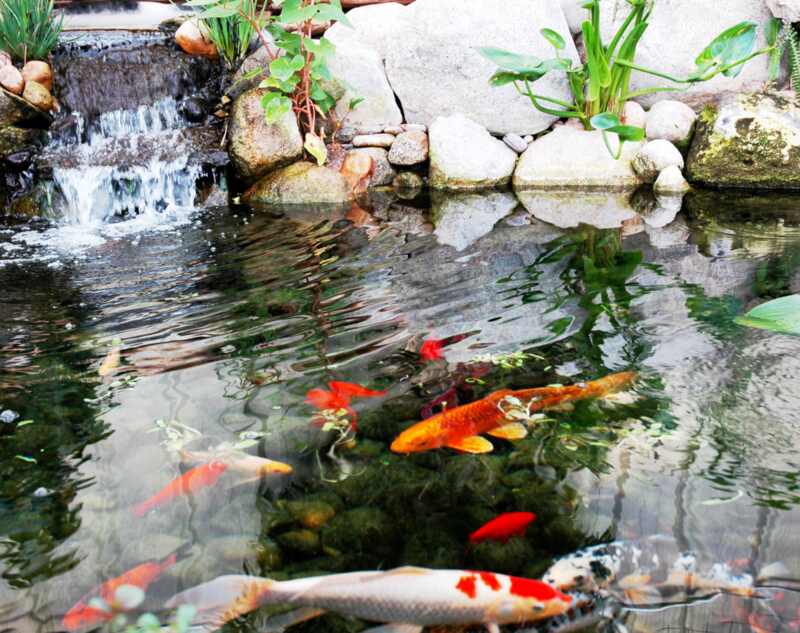
Koi fish need good quality water, clean and rich in oxygen. To keep it like this, you must take care of the filtration system. This includes:
The Skimmer
The skimmer collects floating debris, such as leaves and twigs. Check and clean the skimmer basket weekly or once every few days if heavy foliage surrounds your pond.
Mechanical and Biological Filters
You’ll typically find mechanical and biological filters in the same barrel or box-like container. They collect debris from the water column and neutralize ammonia and nitrites. Clean once every 3 to 4 months, depending on pond size, number of fish, and aquatic vegetation.
UV Lights
Ultraviolet lamps keep algae under control and prevent blooming. Check lamps monthly and replace them if broken.
Check the Water Pump Regularly
The pump keeps the water flowing, ensuring proper filtration and oxygenation. It’s essential to keep it in good shape. Check it monthly or every other month to ensure it’s not clogged by debris and is working fine. To check it, unplug and remove it from the pond. Remove any gunk, sticks, rocks, and other debris.
Keep Pond Plants Under Control
Water plants make a sparse koi pond look green and lush and benefit your ecosystem. But keeping them under control is essential, particularly for fast-growing floaters such as water lettuce and duckweed that can overtake the water’s surface.
Ensure your koi pond plants cover under 50% of the water surface. During the nighttime, aquatic plants use oxygen instead of carbon dioxide. Too many can deplete the resources your koi require to live.
Don’t Overcrowd Your Koi Pond
You see a fantastic koi swimming in the aquarium at the store, and you feel it’s meant for you. Before taking it back home, remember you should only grow ten koi or less per 100 gallons of water. Otherwise, you’ll overcrowd the pond and risk:
- Stressing the fish and making them vulnerable to diseases.
- Creating more debris and affecting water quality and fish health.
Overcrowding can be solved by taking out some of the fish and selling them to another pond owner or building a larger fish pond.
Take Care of Aquascape Design
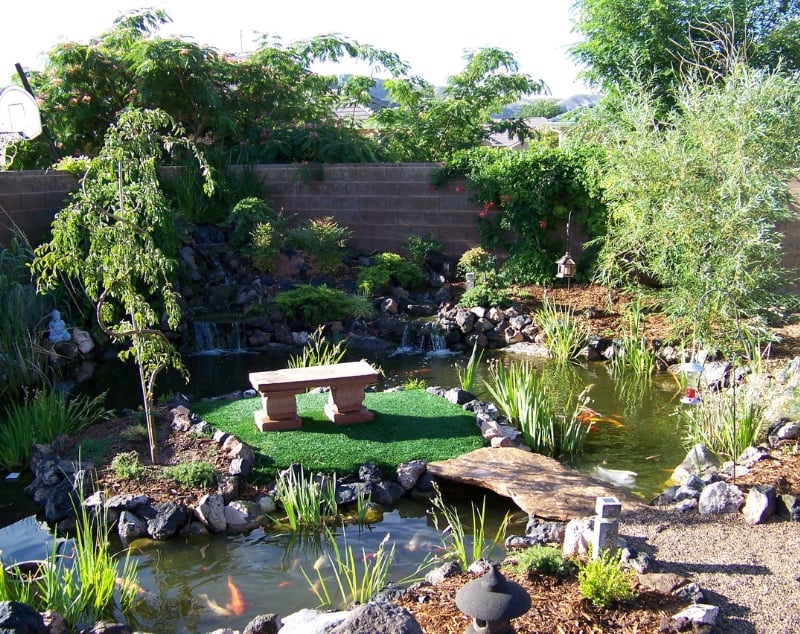
Aquascape maintenance is not as vital as keeping the water clear and the koi healthy, but it’s still meaningful. Occasionally, take the time to check how your koi pond looks:
- Are there places where the pond liner shows from under the gravel and mulch?
- Have rocks moved around the pond, looking not quite right?
- Did your aquatic plants overgrow their intended area? Or do you want to add more colors?
- Have you considered adding koi mates such as goldfish, catfish, and grass carp?
- Has gravel slipped from the skimmer margins? Is there a better way to hide your filters?
- Do you need to replace broken pond lights?
- Are you thinking of adding a bridge over the pond? Or another waterfall?
Maintaining your koi pond also involves keeping the aquascape beautiful and making it more attractive with some new koi pond design ideas.
Create a Schedule
Whether you have lots of free time or you’re stretched between your job and family, you need a koi pond maintenance schedule – nothing fancy, just a guideline to keep you in check and ensure you don’t miss anything important.
Start with a simple draft. You’ll perfect it in time while you get to know your fish, plants, and your pond’s needs. Invite the family to chip in. Pond maintenance is a great outdoor activity.
Here’s a basic list of tasks you need to consider:
| Task | When/How Often |
| Feed the koi | 2 to 4 times a day |
| Scoop up floating debris | Daily |
| Test the pond water | Weekly |
| Clean the skimmer | Weekly |
| Partially replace water | Weekly/Monthly |
| Add beneficial bacteria | Monthly |
| Trim plants | Monthly |
| Check and clean filters | Monthly |
| Check water pump | Monthly |
Keep in mind that the pond ecosystem changes with the season, and you’ll also have to adjust pond maintenance here and there.
Follow Seasonal Changes
With the passing of seasons, your koi pond experiences differences in temperature, sun exposure, vegetation growth, and koi behavior. Here’s what you need to consider, from the hottest days to the dead of winter.
Summer
Summer days come with warmer water and prolonged sun exposure. Your pond water keeps less oxygen, and koi and plants use more since they are highly active. During summer, consider the following:
- Adding an extra aeration device if there are signs of oxygen depletion.
- Replacing water more often to keep it cool.
- Cleaning algae blooms frequently.
- Treating the water for unwanted bacteria.
- Adding beneficial bacteria.
- Cutting out and thinning overgrown aquatic plants.
Fall
Autumn is the season of fallen leaves, decreasing temperature, and some winter preparation. Plan for the following:
- Skim fallen leaves and other debris on the pond’s surface more often.
- Trim and prune aquatic perennials hardy to your location.
- Move annual pond plants indoors with their pots or add them to compost.
- Change the koi feeding schedule to fit their slowing metabolism.
- Check koi’s health and treat any ill fish.
Most homeowners will include a professional pond cleaning at this time to prepare the pond for winter.
Winter
During winter months, koi metabolism slows down. They eat and swim less. If the water temperature drops below 48°F, they enter hibernation and stop eating entirely. Preparing the pond for this stage is called winterization and involves:
- Turning off waterfalls and fountains
- Emptying the filtration system (if you expect freezing temperatures)
- Installing a floating de-icer that allows oxygen into the pond and toxic gasses out
- Adding an aerator to keep water moving and oxygenated
- Spreading a pond net over the water surface to keep any remaining leaves from getting into the water
Spring
Spring pond cleaning is essential for a fresh start. Before the water warms up and the pond comes to life, make sure you:
- Clean the pond thoroughly of all large and tiny debris.
- Pressure-wash the muck and gunk on gravel and rocks.
- Clean and test the pump, filters, skimmer, and aerators.
- Turn on the filtration system.
- Replace filters if necessary.
- Change the water.
- Check the liner and visible pipes.
- Trim the perennial plants.
You’ll also need to change the koi food slowly towards a warm season type and add annual plants as the temperature rises. Since spring cleaning sets the tone for the entire year, most homeowners use this opportunity for professional pond cleaning.
Go for a Professional Pond Cleaning Once a Year
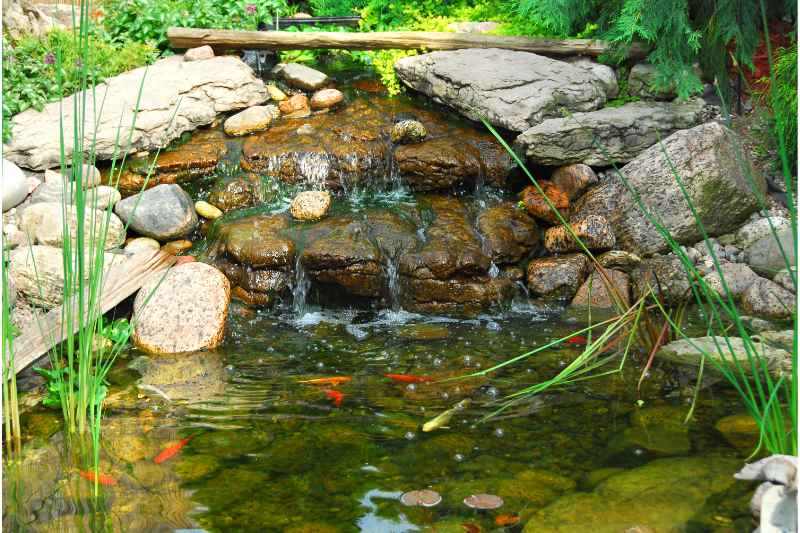
Daily, weekly, and even monthly DIY maintenance is easy once you familiarize yourself with how to clean koi ponds. But a full cleanup is another story, and it’s better done by a professional. Besides all the equipment you need, the experience is usually a tie-breaker. Pros are very good at:
- Catching hidden flows in your filtration system
- Observing plants that might puncture your liner
- Cleaning even a large pond in a short time
- And most importantly – keeping your koi safe while doing it
This is why most pond owners prefer to hire a professional to clean the koi pond from top to bottom at least once a year. The best moment to go for a pro koi pond service is spring or fall. You’ll typically pay $850 to $950 for a cleanup, but the cost depends on pond size, location, etc. We have a detailed pricing guide on pond maintenance, where you can read more about this.
FAQ
How Much Does a Koi Pond Cost?
The average koi pond installation costs $5,100 to $15,900 per project. Pricing depends on pond size, design, location, materials, plants, and fish. See our guide on how to build a small backyard pond to see if the DIY route might be an option for you to help you save money.
Are Koi Ponds High Maintenance?
Well-designed koi pond ecosystems are pretty low-maintenance. You need to take care of the fish and the filtration system and keep the water clean, but there are just a few tasks you need to add to your calendar. If the pond is overcrowded, has too many plants, or the pump is not powerful enough, then yes, you can expect high maintenance.
Do Koi Ponds Need to be Cleaned?
Yes, even complex ecosystem koi ponds need to be deep-cleaned once a year to remove muck, algae, and debris.
How Often Does a Koi Pond Need to be Cleaned?
Koi pond cleaning routines depend on the season. But to keep your fish healthy, you need to have a full clean-up at least once a year, in the fall or spring (ideally both). Winter is a hibernating period, so the pond needs to be squeaky clean to avoid health issues, and spring cleaning prepares the pond for a new cycle.
How Much Does Koi Pond Maintenance Cost?
Expect to pay $1,000 to $2,000 a year for koi pond maintenance, depending on the size of the pond and what services you decide to pay for.
See the answers to the top 10 koi pond FAQs for more information.
Get Your Koi Pond Crystal Clear Today
Although amazingly beautiful and uniquely personal, sometimes you might need help to clean a koi pond well. Do you see muck on the bottom? Is the water not as clear as you’d like? Or is it time for the annual full clean-up to make it shine? Find a local landscape expert who can provide you with answers and assist with getting your koi pond crystal clear today.
Main Image Credit: Aqua Mechanical / Flickr / CC BY 2.0
